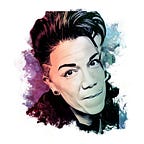Growing Up Str8: Breaking the Mold of Social Gender Dysphoria
M y story is not unique; many humans have felt uncomfortable with the gender they were born into. A major factor of this is due to society’s determination of what standards should apply to gender. Focusing particularly with American culture (because it is where I live), males have been expected to be the masculine role; strength, aggression, and dominance. While females have been expected to take on the feminine role of being passive, nurturing, and subordinate. Clothing, colors, careers, character, are all defined by your gender. Men open doors for women. Nurses should be female. Because of the expectations that parents and elders bestow upon the youth, it is no wonder children grow up taking on a role they might not always identify with.
A s a child, I had a tough outer exterior, with a soft, tender, emotional interior. A tom boy is what I was often referred to, yet often teased for being emotionally sensitive. In my heart, it felt natural to excel at all sports, wrestle with boys, ride BMX bicycles, and prefer wearing pants over dresses. But a lot of my elders did not care for this behavior and often guilted me into fearing I would never find a husband if I kept acting like a boy. A boy? That was such a conflicting ideal for me; especially since I also had no clue I was a lesbian until after I married my husband (see my other blog — The Evolution of Marriage: Going From Forever To Whenever). This is not to say that a straight women couldn’t love these same things, but when society forces you into a category, you begin to question who you really are. I was raised to believe that only str8 people existed; that I was heterosexual and had to act “like a female”. I recall being forced to wear skirts and dresses during my entire 7th grade year of school. I felt like I was in costume. I was so uncomfortable and awkward, and I was sure everyone thought I looked as ridiculous as I did.
W hile I never had thoughts of being transgender (I do not identify as Transgender), and changing my anatomy to reflect male genitalia, I would look to males as role models for being physically fit or how to excel in life because they were always portrayed as being strong and successful when I was growing up. And yet, I continued to confine myself into the stereotypical female mold, which included searching for a man so I could live out the typical hetero life of marriage and motherhood. I took to heart what my family ingrained into my pysche and lived a lie for 29 years. This took a toll both on my emotional and psychological state as my gender role confusion continued to manifest. But, after coming out and realizing I am homosexual, I found myself feeling far more comfortable and natural wearing men’s clothing, and cologne. I associated loving women as having to be more masculine, but found myself going back and forth with how I should look and dress. Looking back at the constant change and flux in my appearance, one would assume I was in the witness protection program, trying to fit into mold after mold. It didn’t help that my fashion would change depending upon the job I held down. Especially as a female working for Corporate America where looking clean cut, responsible, and essentially like a ‘Stepford Wife’ was expected and often required. At times I would rebel with crazy colors in my hair. After I turned 42, I discovered a love for tattoos, and having my ears gauged to a size zero — making sudden and dramatic changes in my physical appearance to feel more in control of who I am.
D uring one of my recent podcast interview with a good friend and musician, my mind was opened to the idea that perhaps some of those who identify as transgender merely do so because of society’s gender dysphoria. Studies have shown that many who suffer from gender [role] identity crisis like myself have deep, emotional scarring that stems from early childhood. Why can’t a man where dresses? Just because you are nurturing shouldn’t automatically mean you are female. Of course we cannot discredit that certain clothing styles reflect the human anatomy; men’s pants will provide more room in the crotch, while women’s tops are darted to accent the waist and hips. But, not all women are shaped like an hour glass, and some men have really big asses. While some men prefer form-fitting attire, some women like to wear loose-fitting materials that flow. Flowered prints and the color pink should be acceptable for any gender.
B ut despite all of the labels and categories, I have finally discovered the ability to embrace my handsome side. I am learning that being beautiful is a non-gender feeling; I can be both because it radiates from within. My gender will no longer define who I am, nor who I should be attracted to. This breakthrough has brought about a level of confidence, and a peace within my heart. I feel free. I feel more…me. This is just the beginning as I continue to do away with insecurities and past beliefs. And as an entrepreneur, a mother, a friend, a lover, I hope to inspire many others to… JUST BE YOU. Be confident. Be true to yourself. The world and future generations need you to.
